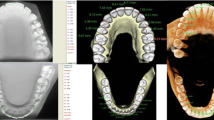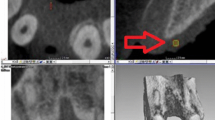Abstract
Objective
The aim of this in vitro study was to evaluate the reliability and accuracy of linear measurements on three-dimensional (3D) surface models obtained by standard pre-set thresholds in two segmentation software programs.
Materials and methods
Ten mandibles with 17 silica markers were scanned for 0.3-mm voxels in the i-CAT Classic (Imaging Sciences International, Hatfield, PA, USA). Twenty linear measurements were carried out by two observers two times on the 3D surface models: the Dolphin Imaging 11.5 (Dolphin Imaging & Management Solutions, Chatsworth, CA, USA), using two filters(Translucent and Solid-1), and in the InVesalius 3.0.0 (Centre for Information Technology Renato Archer, Campinas, SP, Brazil). The physical measurements were made by another observer two times using a digital caliper on the dry mandibles.
Results
Excellent intra- and inter-observer reliability for the markers, physical measurements, and 3D surface models were found (intra-class correlation coefficient (ICC) and Pearson’s r ≥ 0.91). The linear measurements on 3D surface models by Dolphin and InVesalius software programs were accurate (Dolphin Solid-1 > InVesalius > Dolphin Translucent). The highest absolute and percentage errors were obtained for the variable R1–R1 (1.37 mm) and MF–AC (2.53 %) in the Dolphin Translucent and InVesalius software, respectively.
Conclusion
Linear measurements on 3D surface models obtained by standard pre-set thresholds in the Dolphin and InVesalius software programs are reliable and accurate compared with physical measurements.
Clinical relevance
Studies that evaluate the reliability and accuracy of the 3D models are necessary to ensure error predictability and to establish diagnosis, treatment plan, and prognosis in a more realistic way.

Similar content being viewed by others
References
Blattner TC, George N, Lee CC, Kumar V, Yelton CD (2010) Efficacy of cone-beam computed tomography as a modality to accurately identify the presence of second mesiobuccal canals in maxillary first and second molars: a pilot study. J Endod 36:867–870
Rosenberg PA, Frisbie J, Lee J, Lee K, Frommer H, Kottal S, Phelan J, Lin L, Fisch G (2010) Evaluation of pathologists (histopathology) and radiologists (cone beam computed tomography) differentiating radicular cysts from granulomas. J Endod 36:423–428
Garib DG, Raymundo Jr R, Raymundo MV, Raymundo DV, Ferreira SN (2007) Cone beam computed tomography (CBCT): understandind this new imaging diagnostic method with promissing application in Orthodontics. Dental Press J Orthod 141:139–156
Berco M, Rigali PH Jr, Miner RM, DeLuca S, Anderson NK, Will LA (2009) Accuracy and reliability of linear cephalometric measurements from cone-beam computed tomography scans of a dry human skull. Am J Orthod Dentofacial Orthop 136(17):e11–19
Moreira CR, Sales MA, Lopes PM, Cavalcanti MG (2009) Assessment of linear and angular measurements on three-dimensional cone-beam computed tomographic images. Oral Surg Oral Med Oral Pathol Oral Radiol Endod 108:430–436
Scarfe WC, Farman AG, Sukovic P (2006) Clinical applications of cone-beam computed tomography in dental practice. J Can Dent Assoc 72:75–80
Periago DR, Scarfe WC, Moshiri M, Scheetz JP, Silveira AM, Farman AG (2008) Linear accuracy and reliability of cone beam CT derived 3-dimensional images constructed using an orthodontic volumetric rendering program. Angle Orthod 78:387–395
Damstra J, Fourie Z, Huddleston Slater JJ, Ren Y (2010) Accuracy of linear measurements from cone-beam computed tomography-derived surface models of different voxel sizes. Am J Orthod Dentofacial Orthop 137(16):e11–16
Gribel BF, Gribel MN, Frazao DC, McNamara JA Jr, Manzi FR (2011) Accuracy and reliability of craniometric measurements on lateral cephalometry and 3D measurements on CBCT scans. Angle Orthod 81:26–35. doi:10.2319/032210-166.1
Engelbrecht WP, Fourie Z, Damstra J, Gerrits PO, Ren Y (2013) The influence of the segmentation process on 3D measurements from cone beam computed tomography-derived surface models. Clin Oral Investig 17:1919–1927. doi:10.1007/s00784-012-0881-3
Nada RM, van Loon B, Maal TJ, Berge SJ, Mostafa YA, Kuijpers-Jagtman AM, Schols JG (2013) Three-dimensional evaluation of soft tissue changes in the orofacial region after tooth-borne and bone-borne surgically assisted rapid maxillary expansion. Clin Oral Investig 17:2017–2024. doi:10.1007/s00784-013-0927-1
Choi JY, Choi JH, Kim NK, Kim Y, Lee JK, Kim MK, Lee JH, Kim MJ (2002) Analysis of errors in medical rapid prototyping models. Int J Oral Maxillofac Surg 31:23–32
Lopes PM, Moreira CR, Perrella A, Antunes JL, Cavalcanti MG (2008) 3-D volume rendering maxillofacial analysis of angular measurements by multislice CT. Oral Surg Oral Med Oral Pathol Oral Radiol Endod 105:224–230
Brown AA, Scarfe WC, Scheetz JP, Silveira AM, Farman AG (2009) Linear accuracy of cone beam CT derived 3D images. Angle Orthod 79:150–157
Ballrick JW, Palomo JM, Ruch E, Amberman BD, Hans MG (2008) Image distortion and spatial resolution of a commercially available cone-beam computed tomography machine. Am J Orthod Dentofacial Orthop 134:573–582
Loubele M, Jacobs R, Maes F, Denis K, White S, Coudyzer W, Lambrichts I, van Steenberghe D, Suetens P (2008) Image quality vs radiation dose of four cone beam computed tomography scanners. Dentomaxillofac Radiol 37:309–318
Damstra J, Fourie Z, Huddleston Slater JJ, Ren Y (2011) Reliability and the smallest detectable difference of measurements on 3-dimensional cone-beam computed tomography images. Am J Orthod Dentofacial Orthop 140:e107–114
Kim M, Huh KH, Yi WJ, Heo MS, Lee SS, Choi SC (2012) Evaluation of accuracy of 3D reconstruction images using multi-detector CT and cone-beam CT. Imaging Sci Dent 42:25–33. doi:10.5624/isd.2012.42.1.25
Mischkowski RA, Pulsfort R, Ritter L, Neugebauer J, Brochhagen HG, Keeve E, Zoller JE (2007) Geometric accuracy of a newly developed cone-beam device for maxillofacial imaging. Oral Surg Oral Med Oral Pathol Oral Radiol Endod 104:551–559
Lagravere MO, Carey J, Toogood RW, Major PW (2008) Three-dimensional accuracy of measurements made with software on cone-beam computed tomography images. Am J Orthod Dentofacial Orthop 134:112–116
Sun Z, Smith T, Kortam S, Kim DG, Tee BC, Fields H (2011) Effect of bone thickness on alveolar bone-height measurements from cone-beam computed tomography images. Am J Orthod Dentofacial Orthop 139:e117–127
Baumgaertel S, Palomo JM, Palomo L, Hans MG (2009) Reliability and accuracy of cone-beam computed tomography dental measurements. Am J Orthod Dentofacial Orthop 136:19–25
Al-Rawi B, Hassan B, Vandenberge B, Jacobs R (2010) Accuracy assessment of three-dimensional surface reconstructions of teeth from cone beam computed tomography scans. J Oral Rehabil 37:352–358
Hassan B, van der Stelt P, Sanderink G (2009) Accuracy of three-dimensional measurements obtained from cone beam computed tomography surface-rendered images for cephalometric analysis: influence of patient scanning position. Eur J Orthod 31:129–134
Grauer D, Cevidanes LS, Proffit WR (2009) Working with DICOM craniofacial images. Am J Orthod Dentofacial Orthop 136:460–470
Conflict of interest
The authors declare that they have no conflict of interest.
Author information
Authors and Affiliations
Corresponding author
Rights and permissions
About this article
Cite this article
Poleti, M.L., Fernandes, T.M.F., Pagin, O. et al. Analysis of linear measurements on 3D surface models using CBCT data segmentation obtained by automatic standard pre-set thresholds in two segmentation software programs: an in vitro study. Clin Oral Invest 20, 179–185 (2016). https://doi.org/10.1007/s00784-015-1485-5
Received:
Accepted:
Published:
Issue Date:
DOI: https://doi.org/10.1007/s00784-015-1485-5




